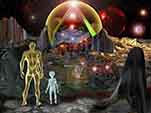HARVARD AND THE MAKING OF THE UNABOMBER 1/2 by Alston Chase © 2000 The Atlantic Monthly, June 2000
http://www.newsmakingnews.com/unabomber%20article.htm
In the fall of 1958 Theodore Kaczynski, a brilliant but vulnerable boy of sixteen, entered Harvard College. There he encountered a prevailing intellectual atmosphere of anti-technological despair. There, also, he was deceived into subjecting himself to a series of purposely brutalizing psychological experiments--experiments that may have confirmed his still-forming belief in the evil of science. Was the Unabomber born at Harvard? A look inside the files.
Like many Harvard alumni, I sometimes wander the neighborhood when I return to Cambridge, reminiscing about the old days and musing on how different my life has been from what I hoped and expected then. On a trip there last fall I found myself a few blocks north of Harvard Yard, on Divinity Avenue. Near the end of his this dead-end street sits the Peabody Museum--a giant Victorian structure attached to the Botanical Museum, where my mother had taken me as a young boy, in 1943, to view the spectacular exhibit of glass flowers. These left such a vivid impression that a decade later my recollection of tem inspire me, then a senior in high school to apply to Harvard.
This time my return was prompted not by nostalgia but by curiosity. No. 7 Divinity Avenue is a modern multi-story academic building today, housing the university's Department of molecular and Cellular biology. In 1959 a comfortable old house stood on the site. Known as the Annex, it served as a laboratory in which staff members of the Department of Social Relations conducted research on human subjects. There, form the fall of 1959 through the spring of 1962, Harvard psychologists, led by Henry A. Murray, conducted a disturbing and what would not be seen as ethically indefensible experiment on twenty-two undergraduates. To preserve the anonymity of these student guinea pigs, experiments referred to individuals by code name only. One of these students, whom they dubbed "Lawful," was Theodore John Kaczynski, who would one day be known as the Unabomber, and who would later mail or deliver sixteen package bombs to scientists, academicians, and others over seventeen years, killing three people and injuring twenty-three.
I had a special interest in Kaczynski. For may years he and I had lived parallel lives to some degree. Both of us had attended public high schools and had then gone on to Harvard, from which I graduated in 1957, he in 1962. At Harvard we took many of the same courses from the same professors. We were both graduate students and assistant professors in the 1960s. I studied at Oxford and received a Ph.D. in philosophy from Princeton before joining the faculty at Ohio State and later serving as chairman of the Department of Philosophy at Macalester College in Minnesota. Kaczynski earned a Ph.D. in mathematics at the University of Michigan in 1967 and then joined the Berkeley Department of Mathematics as an instructor. In the early 1970s, at roughly the same time, we separately fled civilization to the Montana wilderness.
In 1971, Kaczynski moved to great Falls, Montana; that summer he began building a cabin near the town of Lincoln, eighty miles southwest of Great Falls, on a lot he and his brother, David, had bought. In 1972, my wife and I bought an old homestead fifty-five miles south of Great Falls. Three years later we gave up our teaching jobs to live in Montana full-time. Our place had neither telephone nor electricity; it was ten miles from the nearest neighbor. In winter we were snowbound for months at a time.
In our desire to leave civilization Kaczynski and I were not alone. Many others sought a similar escape. What, I wondered, had driven Kaczynski into the wilderness, and to murder? To what degree were his motives simply a more extreme form of the alienation that prompted to many of us to seek solace in the backwoods?
Most of us may believe we already know Kaczynski. According to the conventional wisdom Kaczynski, a brilliant former professor of mathematics turned Montana hermit and mail bomber, is simply, mentally ill. He is a paranoid schizophrenic, and there is nothing more about him to interest us. But the conventional wisdom is mistaken. I came to discover that Kaczynski is neither the extreme loner he has been made out to be nor in any clinical sense mentally ill. He is an intellectual and a convicted murderer, and to understand the connections between these two facts we must revisit his time at Harvard.
I first heard of the Murray experiment from Kaczynski himself. We had begun corresponding in July of 1998, a couple of months after a federal court in Sacramento sentence him to life without possibility of parole. Kaczynski, I quickly discovered, was an indefatigable correspondent. Sometimes his letters to me came so fast that was as difficult to answer one before the next arrived The letters were written with great humor, intelligence, and care. And, I found, he was, in his own way, a charming correspondent. He has apparently carried on a similarly voluminous correspondence with many others, often developing close friendships with them through the mail.
Kaczynski told me that the Henry A. Murray Research Center of the Radcliffe Institute for Advance Study, although it released some raw data about him to his attorneys, had refused to share information about the Murray team's analysis of that data. Kaczynski hinted darkly that the Murray Center seemed to feel it had something to hide. One of his defense investigators, he said, reported that the center had told participating psychologist not to talk with his defense team.
After this intriguing start Kaczynski told me little more about the Murray experiment than what I could find in he published literature. Henry Murray's widow, Mina, was friendly and cooperative, but could provide few answers to my questions. Several of the research assistants I interviewed couldn't or wouldn't talk much about the study. Nor could the Murray Center be entirely forthcoming. After considering my application, its research committee approved my request to view the records of this experiment, the so-called data set, which referred to subjects by code names only. But because Kaczynski's alias was by then known to some journalists, I was not permitted to view his records.
Through research at the Murray Center and in the Harvard archives I found that, among its other purposes, Henry Murray's experiment was intended to measure how people react under stress. Murray subjected his unwitting students, including Kaczynski, to intensive interrogation--what Murray himself called "vehement, sweeping, and personally abusive" attacks, assaulting his subjects' egos and most-cherished ideals and beliefs.
My quest was specific--to determine what effects, if any, the experiment may have had on Kaczynski. This was a subset of a larger question: What effects had Harvard had on Kaczynski? In 1998, as he faced trial for murder, Kaczynski was examined by Sally Johnson, a forensic psychiatrist with the U.S. Bureau of Prisons, at the order of court. In her evaluation Johnson wrote that Kaczynski "has intertwined his two belief systems, that society is bad and he should rebel against it, and his intense anger at his family for his perceived injustices." The Unabomber was created when these two belief systems converged. And it was at Harvard, Johnson suggested, that they first surfaced and met. She wrote:
During his college year he had fantasies of living a primitive life and fantasized himself as "an agitator, rousing mobs to frenzies of revolutionary violence." He claims that during that time he started to think about breaking away from normal society.
It was at Harvard that Kaczynski first encountered the ideas about the evils of society that would provide a justification for and a focus to an anger he had felt since junior high school. It was at Harvard that he began to develop these ideas into his anti-technology ideology of revolution. It as at Harvard that Kaczynski began to have fantasies of revenge, began to dream of escaping into wilderness. And it as at Harvard, as far as can be determined that he fixed on dualistic ideas of good and evil, and on a mathematical cognitive style that led him to think he could find absolute truth through the application of his own reason. Was the Unabomber--"the most intellectual serial killer the nation has ever produced," as one criminologist has called him--born at Harvard?
THE MANIFESTO
The story of Kaczynski's crimes began more than twenty-two years ago, but the chain of consequences they triggered has yet to run its course. Dubbed "the Unabomber" by the FBI because his early victims were associated with universities or airlines, Kaczynski conducted an increasingly lethal campaign of terrorism that began on May 26, 1978, when the first bomb slightly injured a Northwestern University public-safety officer, Terry Marker, and ended on April 24, 1995, when a bomb he had mailed killed the president of the California Forestry Association, Gilbert Murray. Yet until 1993 Kaczynski remained mute, and his intentions were entirely unknown.
By 1995 his explosives had taken a leap in sophistication; that year he suddenly became loquacious, writing letters to newspapers, magazines, targets and a victim. Two years later The Washington Post, in conjunction with The New York Times, published copies of the 35,000-word essay that Kaczynski titled "industrial Society and Its Future," and which the press called "The Manifesto."
Recognizing the manifesto as Kaczynski's writing, his brother, David, turned Kaczynski in to the FBI, which arrested him at his Montana cabin on April 3, 1996. Later that year Kaczynski was removed to California to stand trial for, among other crimes, two Unabomber murders committed in that state. On January 8, 1998, having failed to dissuade his attorneys from their intention of pressing an insanity defense, and having failed to persuade the presiding judge, Garland E. Burrell Jr. to allow him to choose a new attorney, Kaczynski asked the court for permission to represent himself. In response Burrell ordered Sally Johnson to examine Kaczynski, to determine if he was competent to direct his own defense. Johnson offered a "provisional" diagnosis of paranoid schizophrenia, but she concluded that Kaczynski was nevertheless competent to represent himself. Burrell refused to allow it. Faced with the prospect of a humiliating trial in which is attorney would portray him as insane and his philosophy as the ravings of a madman, Kaczynski capitulated; in exchange for the government's agreement not to seek the death penalty, he pleaded guilty to thirteen federal bombing offenses that killed three men and seriously injured two others, and acknowledged responsibility for sixteen bombings from 1978 to 1995. On May 4, 1998, he was sentenced to life in prison without possibility of parole.
Driving these events from first bomb to plea bargain was Kaczynski's strong desire to have his ideas--as described in the manifesto--taken seriously.
"The Industrial Revolution and its consequences," Kaczynski's manifesto begins, "have been a disaster for the human race." They have led, it contends, to the grown of at technological system dependent on a social, economic and political order that suppresses individual freedom and destroys nature. "The system does not and cannot exist to satisfy human needs. Instead, it is human behavior that has to be modified to fit the needs of the system."
By forcing people to conform to machines rather than vice versa, the manifesto states, technology creates a sick society hostile to human potential. Because technology demands constant change, it destroys local, human-scale communities. Because it requires a high degree of social and economic organization, it encourages the grown of crowded and unlivable cities and of mega-states indifferent to the needs of citizens.
This evolution toward a civilization increasingly dominated by technology and the power structure serving technology, the manifesto argues, cannot be reversed on its own, because "technology is a more powerful social force than the aspiration for freedom," and because "while technological progress AS A WHOLE continually narrows our sphere of freedom, each new technical advance CONSIDERED BY ITSELF appears to be desirable." Hence science and technology constitute "a mass power movement, and many scientist gratify their need for power through identification \with this mass movement." Therefore "the technophiles are taking us all on an utterly reckless rider into the unknown."
Because human beings must conform to the machine, our society tends to regard as a "sickness" any mode of thought or behavior that is inconvenient for the system, and this is plausible because when an individual doesn't fit into the system it causes pain to the individual as well as problems for the system. Thus the manipulation of an individual to adjust him to the system is seen as a "cure" for a "sickness" and therefore is good.
This requirement, the manifesto continues, has given rise to a social infrastructure dedicated to modifying behavior. This infrastructure includes an array of government agencies with ever-expanding police powers, an out-of-control regulatory system that encourages the limitless multiplication of laws, an education establishment that stresses conformism, ubiquitous television networks whose fare is essentially an electronic form of Valium, and a medical and psychological establishment that promotes the indiscriminate use of mind-altering drugs.
Since the system threatens humanity's survival and cannot be reformed, Kaczynski argued, it must be destroyed. Indeed, the system will probably collapse on its own, when the weight of human suffering it creates become unbearable. But the longer it persists, the more devastating will be the ultimate collapse. Hence, "revolutionaries" like the Unabomber "by hastening the onset of the breakdown will be reducing the extent of the disaster."
"We have no illusions about the feasibility of creating a new, ideal form of society, "Kaczynski wrote. "Our goal is only to destroy the existing form of society." But this movement does have a further goal. It is to protect "wild nature," which is the opposite of technology. Admittedly, "eliminating industrial society" may have some "negative consequences," but "well, you can't eat your cake and have it too." .......
The Unabomber's manifesto was greeted in 1995 by many thoughtful people as a work of genius, or at least profundity, and as quite sane. In The New York Times the environmental write Kirkpatrick Sale wrote that the Unabomber "is a rational man and his principal beliefs are, if hardly mainstream, entirely reasonable." In The Nation Sale declared that the manifesto's first sentence "is absolutely crucial for the American public to understand and ought to be on the forefront of the nations' political agenda." The science writer Robert Wright observed in Time magazine, "There's a little bit of the Unabomber in most of us." And essay in The New Yorker by Cynthia Ozick described the Unabomber as America's "own Raskolnikov--the appealing, appalling and disturbingly visionary murderer of `Crime and Punishment,' Dostoyevsky's masterwork of 1866." Ozick called the Unabomber a "philosophical criminal of exceptional intelligence and humanitarian purpose, who is driven to commit murder out of an uncompromising idealism." sites devoted to the Unabomber multiplied on the Internet--the Church of Euthanasia Freedom Club; Unpack, the Unabomber Political Action Committee; alt.fan.unabomber; Chuck's Unabomb Page; redacted.com; MetroActive; and Steve Hau's Rest Stop. The University of Colorado hosted a panel titled "The Unabomber Had a Point."
By 1997, however, when Kaczynski's trial opened, the view had shifted. Although psychiatrists for the prosecution continued to cite the manifesto as proof of Kaczynski's sanity, experts for the defense and many in the media now view it as a symptom and a product of severe mental illness. The document, they argued, revealed a paranoid mind. During the trial the press frequently quoted legal experts who attested to Kaczynski's insanity. Gerald Lefcourt, then the president of the National Association of Criminal Defense Lawyers, said the defendant was "obviously disturbed." Donald Heller, a former federal prosecutor, said, "This guy is not playing with a full deck." The writer Maggie Scarf suggested in The New Republic that Kaczynski suffered from "Narcissistic Personality Disorder."
Michael Mello, a professor at Vermont Law School is the author of The United States of America vs. Theodore John Kaczynski. He and William Finnegan, a writer for The New Yorker, have suggested that Kaczynski's brother, David, his mother, Wanda, and their lawyer, Tony Bisceglie, along with Kaczynski's defense attorneys, persuaded many in the media to portray Kaczynski as a paranoid schizophrenic. To a degree this is true. Anxious to save Kaczynski from execution, David and Wanda gave a succession of interview from 1996 onward to The Washington Post, The New York Times and Sixty Minutes, among other outlets, in which they sought to portray Kaczynski as mentally disturbed and pathologically anti-social since childhood. Meanwhile--against his wishes and without his knowledge, Kaczynski insists--his attorneys launched a mental-health defense for their client.
One psychology expert for the defense, Karen Bronk Froming, concluded that Kaczynski exhibited a "predisposition to schizophrenia." Another David Vernon Foster, saw "a clear and consistent picture of schizophrenia, paranoid type." Still another, Xavier F. Amador, described Kaczynski as "typical of the hundreds of patients with schizophrenia. " How did the experts reach their conclusions? Although objective tests alone suggested to Froming only that Kaczynski's answers were "consistent with" schizophrenia, she told Finnegan it was Kaczynski's writings--in particular his "anti-technology" views--that cemented this conclusion for her. Foster, who met with Kaczynski a few times but never formally examined him, cited his "delusional themes" as evidence of sickness. Amador, who never met Kaczynski at all, based his ;judgment on the "delusional beliefs" he detected in Kaczynski's writing. And Sally Johnson's provisional diagnosis--that Kaczynski suffered from "Paranoid Type" schizophrenia--was largely based on her conviction that he harbored "delusional beliefs" about the threats posted by technology. The experts also found evidence of Kaczynski's insanity in his refusal to accept their diagnoses or to help them reach those diagnoses.
Most claims of mental illness rested on the diagnoses of experts whose judgments, therefore, derived largely from their opinions of Kaczynski's philosophy and his personal habits--he was a recluse, a wild man in appearance, a slob of a housekeeper, a celibate--and from his refusal to admit he was ill. Thus Froming cited Kaczynski's "unawareness of his disease" as an indication of illness. Foster complained of the defendant's "symptom-based failure to cooperate fully with psychiatric evaluation." Amador said that the defendant suffered "from severe deficits in awareness of illness."
But Kaczynski was not more unkempt than many other people on our streets. His cabin was no messier than the offices of many college professors. The Montana wilds are filled with escapists like Kaczynski (and me). Celibacy and misanthropy are not diseases. Nor was Kaczynski really so much of a recluse. Any reporter could quickly discover, as I did through interview with scores of people who have know Kaczynski (classmates, teachers, neighbors), that he was not the extreme loner he has been made out to be. And, surely, a refusal to admit to being insane or to cooperate with people who are paid to pronounce one insane cannot be taken seriously as proof of insanity.
Why were the media and the public so ready to dismiss Kaczynski as crazy? Kaczynski kept voluminous journals, and in one entry, apparently from before the bombing started, he anticipated this question.
I intend to start killing people. If I am successful at this, it is possible that, when I am caught (not alive, I fervently hope!) there will be some speculation in the news media as to my motives for killing....If some speculation occurs, they are bound to make me out to be a sickie, and to ascribe to me motives of a sordid or "sick" type. Of course, the term "sick" in such a context represents a value judgment....the news media may have something to say about me when I am killed or caught. And they are bound to try to analyze my psychology and depict me as "sick." This powerful bias should be borne [in mind] in reading nay attempts to analyze my psychology.
Michael Mello suggest that the public wished to see Kaczynski as insane because his ideas are too extreme for us to contemplate without discomfort. He challenges our most cherished beliefs. Mello writes,
The manifesto challenges the basic assumption of virtually every interest group that was involved with the case: the lawyers, the mental health experts, the press and politics--both left and right....Kaczynski's defense team convinced the media and the public that Kaczynski as crazy, even in the absence of credible evidenced...[because] we needed to believe it....They decided that the Unabomber was mentally ill, and his ideas were mad. Then they forgot about the man and his ideas, and created a curative tale.
Mello is only half right. It is true that many believed Kaczynski was insane because they needed to believe it. But the truly disturbing aspect of Kaczynski and his ideas is not that they are so foreign but that they are so familiar. The manifesto is the work of neither a genius nor a maniac. Except for its call to violence, the ideas it expresses are perfectly ordinary and unoriginal, shared by many Americans. Its pessimism over the direction of civilization and its rejection of the modern world are shared especially with the country's most highly educated. The manifesto is, in other words, an academic--and popular--cliché. And if concepts that many of us unreflectively accept can lead a person to commit serial murder, what does that say about us? We need to see Kaczynski as exceptional--madman or genius--because the alternative is so much more frightening.
"EXCEEDINGLY STABLE" ..... Harvard was a "tremendous thing for me," Kaczynski wrote in an unpublished autobiography that he completed in 1998 and showed to me. "I got something that I had been needed all along without knowing it, namely, hard work requiring self-discipline and strenuous exercise of my abilities. I threw myself into this...I thrived on it....Feeling the strength of my own will, I became enthusiastic about will power." .... And indeed, most reports of his teachers, his academic adviser, his housemaster, and the health-services staff suggest that Kaczynski was, in his first year at Harvard, entirely balanced, although tending to be a loner. The health-services doctor who interviewed Kaczynski as part of the medical examination Harvard required for all freshmen observed,
Good impression created. Attractive, mature for age, relaxed...Talks easily, fluently and pleasantly...likes people and gets on well with them. May have many acquaintances but makes friends carefully. Prefers to be by himself part of the time at least. May be slightly shy....Essentially a practical and realistic planner and an efficient worker....Exceedingly stable, well integrated and feels secure within himself Usually very adaptable. May have many achievements and satisfactions.
THE ROOTS OF THE UNABOMBER ... What pressures did Kaczynski face among his family? Kaczynski insists that the Kaczynski home was an unhappy one and that his social isolation came about because his parents pushed him too hard academically.
....in the fifth grade, Kaczynski scored 167 on an IQ test. He skipped the sixth grade, leaving his friends behind to enter a new class as the smallest kid in the room.
From then on according to Kaczynski and also according to others who knew the family, his parents valued his intellect as a trophy that gave Kaczynski special status. They began to push him to study, lecturing him if his report card showed any grade below an A...
Kaczynski was accepted by Harvard in the spring of 1958; he was not yet sixteen years old. One friend remembers urging Kaczynski's father not to let the boy go, arguing, "He's too young, too immature, and Harvard too impersonal." But again Turk wouldn't listen. "Ted's going to Harvard was an ego trip for him," the friend recalls.
GENERAL EDUCATION AND THE CULTURE OF DESPAIR .... According to Perry (Wm. G. Perry Jr., director of the university's Bureau of Study Counsel), intellectual development for Harvard and Radcliffe undergraduates typically encompassed a progression from a simplistic, "dualistic" view of reality to an increasingly relativistic and "contingent" once. Entering freshmen tend to favor simple over complex solution and to divide the world into truth and falsehood, good and bad, friend and foe. yet in most of the5i college course, especially in the social sciences and the humanities, they are taught that truth is relative. Most accept this, but a number cannot. They react against relativism by clinging more fiercely to an absolute view of the world. To some of these students, in Perry's words, "science and mathematics still seem to offer hope."
Nevertheless, Perry wrote, "regression into dualism" is not a happy development, for it "calls for any enemy." Dualists in a relativistic environment then to see themselves as surrounded; they become increasingly lonely and alienated. This attitude "requires an equally absolutistic rejection of any `establishment" and "can call forth in its defenses hate, projection and denial of all distinctions but one, "Perry wrote. "The tendency...is toward paranoia."
As is evident in his writings Kaczynski rejected the complexity and relativism he found in the humanities and the social sciences. He embraced both the dualistic cognitive style of mathematics and Gen Ed's anti-technology message. And perhaps most important, he absorbed the message of positivism, which demanded value-neutral reasoning and preached that (as Kaczynski would later express it in his journal) "there is no logical justification for morality."
THE MURRAY EXPERIMENT
Perhaps no figure at Harvard at this time better embodied the ongoing war between science and humanism than Henry A. "Harry" Murray, a professor in Harvard's Department of Social Relations. A wealthy and blue-blooded New Yorker, Murray was both a scientist and a humanist, and he was one of Lewis Mumford's best friends. He feared for the future of civilization in an age of nuclear weapons and advocated implementing the agenda of the World Federalist Association, which called for a single world government. The atomic bomb, Murray wrote in a letter to Mumford, "is the logical and predictable result of the course we have been madly pursing for a hundred years." The choice now facing humanity, he added, was "one World or No World."
Yet unlike Mumford, Murray maintained a deep faith in science. He saw it as offering a solution by helping to transform the human personality. "the kind of behavior that is required by the present threat." Murray wrote Mumford, "involves transformations of personality such as never occurred quickly in human history; one transformation being that of National Man into World Man." Critical to achieving this change was learning the secret of successful relationships between people, communities, and nations. And coming to understand these "unusually successful relations" was the object of Murray's particular research; the interplay between two individuals, which he called the "dyad."
The concept of the dyad was, in a sense, Murray's attempt to build a bridge between psychology and sociology. Rather than follow Freud and Jung by identifying the individual as the fundamental atom in the psychological universe, Murray chose the dyad--the smallest social unit--and in this way sought to unite psychiatry, which studied the psyches of individuals, and sociology, which studied social relations. This kind of research, he apparently hoped, might (as he put it in a 1947 paper) promote "the survival and further evaluation of Modern Man," by encouraging the emergence of the new "world man" and making world peace more likely.
Murray's interest in the dyad, however, may have been more than merely academic. The curiosity of this complex man appears to have been impelled by two motives--one idealistic and the other somewhat less so. He lent his talents to national aims during World War II. Forrest Robinson, the author of a 1992 biography of Murray, wrote that during this period he "flourished as a leader in the global crusade of good against evil." He was also an advocate of world government. Murray saw understanding the dyad, it seems, as a practical took in the service of the great crusade ion both its hot and cold phases. (He had long shown interest, for example, in the whole subject of brainwashing.) During he war Murray served in the Office of Strategic Services, the forerunner of the CIA, helping to develop psychological screening tests for applicants and (according to Timothy Leary) monitoring military experiments on brainwashing. In his book The Search for the Manchurian Candidate" (1979), John Marks reported that General "Wild Bill" Donovan, the OSS director, "called in Harvard psychology professor Henry `Harry' Murray" to devise a system for testing the suitability of applicants to the OSS. Murray and his colleagues "put together an assessment system...[that] tested a recruit's ability to stand up under pressure, to be a leader, to hold liquor, to lie skillfully, and to read a person's character by the nature of his clothing.... Murray's system became a fixture in the OSS."
One of the tests that Murray devised for the OSS was intended to determine how well applicants withstood interrogations. As he and his colleagues described it in their 1948 report "Selection of Personnel for Clandestine Operations--Assessment of Men."
The candidate immediately went downstairs to the basement room. A voice from within commanded him to enter, and on complying he found himself facing a spotlight strong enough to blind him for a moment. the room was otherwise dark. Behind the spotlight sat a scarcely discernible board of inquisitors...The interrogator gruffly ordered the candidate to sit down. when he did so, he discovered that the chair in which he sat was so arranged that the full strength of the beam was focused directly on his face....
At firs the questions were asked in a quiet sympathetic, conciliatory manner, to invite confidence...After a few minutes, however, the examiner worked up to a crescendo in a dramatic fashion....When an inconsistency appeared, he raised his voice and lashed out at the candidate, often with sharp sarcasm. He might even roar, "You're a liar."
Even anticipation of this test was enough to cause some applicants to fall apart. The authors wrote that one person "insisted he could not go through with the test." They continued, "A little later the director...found the candidate in his bedroom, sitting on the edge of his cot, sobbing."
Before the war, Murray had been the director of the Harvard Psychological Clinic. After the war, Murray returned to Harvard where he continued to refine techniques of personality assessment. In 1948 he sent a grant application to the Rockefeller Foundation proposing "the development of a system of procedures for testing the suitability of officer candidates for the Navy." By 1950, he had resumed studies on Harvard undergraduates that he had begun, in rudimentary form, before the war, title "multiform Assessments of Personality Development Among Gifted College Men." The experiment in which Kaczynski participated was the last and most elaborate in the series. In their postwar form these experiments focused on stressful dyadic relations, designing confrontations akin to those mock interrogations he had helped to orchestrate for the OSS.
Planning for the last of Murray's "multiform assessments" was well under way by the spring of 1959. The idea, according to Murray's notes, was to "call for volunteers from a large undergraduate course."
Get about 80 sophomores; administer a series of scales or questionnaires dealing with various dimensions of personality; pick 25 subjects, some extremely high, some extremely low and some in middle on each of these scales; study these 25 subjects over a three year period by the multiform method of assessment; come up with 700 ran orders, and using a computer, obtain clusters of intercorrelations, factors, but final decisions are reached after prolonged discussions and reassessments; enormous amount of data which staff analyzes, interprets, formulates.
Kaczynski told Mello that he was "pressured into participating" in the Murray experiment. His hesitation turned out to be sensible. Researchers gave the volunteers almost no information about the experiment in which they would participate. Each was simply asked to answer yes to the following question: "Would you be willing to contribute to the solution of certain psychological problems (parts of an on-going program of research in the development of personality), by serving as a subject in a series of experiments or taking a number of tests (average about 2 hours a week) through the academic year (at the current College rate per hour)?"
In fact it would never be clear what the "certain psychological problems" were. And the test that served as the centerpiece off this undertaking appears remarkably similar to the old OSS stress test. Students would be given the third degree. But whereas the OSS applicants must have known that enduring unpleasant interrogations could be part of their job, these students did not. The intent was to catch them by surprise, to deceive them, and to brutalize them. As Murray described it,
First, you are told you have a month in which to write a brief exposition of your personal philosophy of life, an affirmation of the major guiding principles in accord with which you live or hope to live.
Second, when you return to the Annex with your finished composition, you are informed that in a day or two you and a talented young lower will be asked to debate the respective merits of your two philosophies.
When the subject arrived for the debate, he was escorted to a "brilliantly lighted room" and seated in front of a one-way mirror. A motion-picture camera recorded his every move and facial expression through a hole in the wall. Electrodes leading to machines that recorded his heart and respiratory rates were attached to his body. Then the debate began. Bu the students were tricked. Contrary to what Murray claimed in his article, they had been led to believe that they would debate their philosophy of life with another student like themselves. Instead they confronted what Forrest Robinson describes as a "well-prepared `stooge"--a talented young lawyer indeed, but one who had been instructed to launch into an aggressive attack on the subject, for the purpose of upsetting him as much as possible.
Robinson has described what happened next.
As instructed, the unwitting subject attempted to represent and to defend his personal philosophy of life. Invariably, however, he was frustrated, and finally brought to expressions of real anger, by the withering assault of his older, more sophisticated opponent...while fluctuations in the subject's pulse and respiration were measured on a cardio tachometer.
Nor surprisingly, most participants found this highly unpleasant, even traumatic, as the data set records, "We were led into the room with bright lights, very bright," one of them, code-named Cringle, recalled afterward.
I could see shadowy activities going on behind the one-way glass...[Dr. G]...started fastening things on me. [I] had a sensation somewhat akin to someone being strapped on the electric chair with these electrodes...I really started getting hit real hard...Wham, wham, wham! And me getting hotter and more irritated and my heart beat going up...and sweating terribly...there I was under the lights and with the movie camera and all this experimentation equipment on me...It was sort of an unpleasant experience.
"Right away," said another, code-named Trump, describing his experience afterward, "I didn't like [the interrogator]."






































